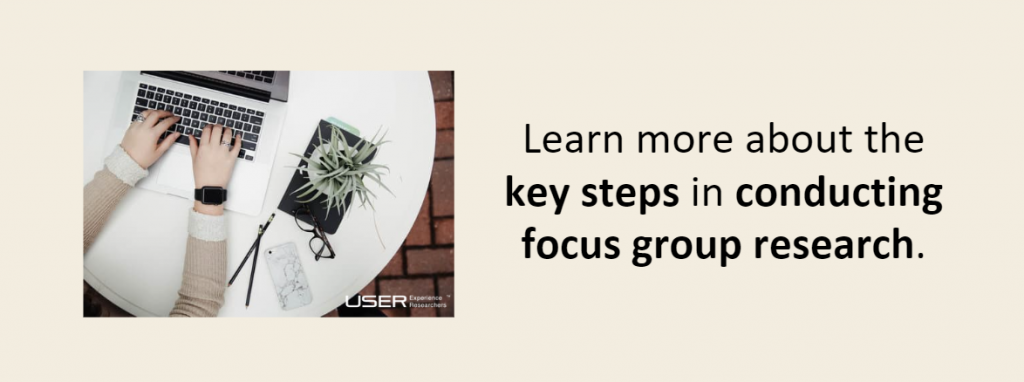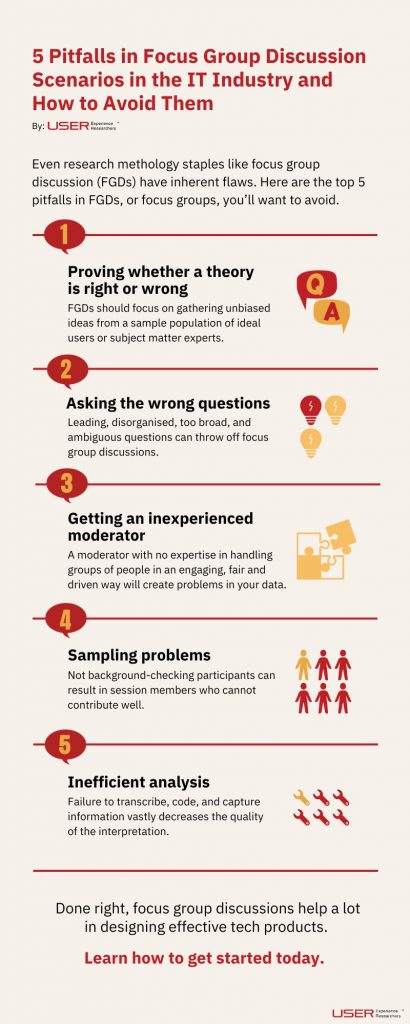
Research methodologies have their pros and cons, and even staples like the vaunted Focus Group Discussion (FGDs) have inherent flaws. It has proven effective and reliable in many cases, if done right. Done wrongly, you may end up with inconsistent results.
Since its development in the 1930s and proliferation in the 1990s, FGDs have helped many companies rise to success as a form of User Experience Research (UX Research). Tech companies also utilised this methodology to produce products that will fit their market, such as Twitter.
You would think such an established process can lead only to great results, but that’s not the case. Automobile giant Chrysler messed up the potential success of its early 2000s product the PT Cruiser in the American market with missteps they did in their FGD.
It’s essential to use FGDs to make sure you get the right kind of details that will influence your decision-making. Here are the top five pitfalls in FGDs, or focus groups, you’ll want to avoid.
1. Proving whether a theory is right or wrong
Sometimes, executives already have an idea in mind, and use focus groups to prove that their theory was right—this is wrong. In doing an FGD, the agendum should focus on getting unbiased ideas from a sample population of ideal users or subject matter experts.
Likewise, an FGD is also not the best venue for usability testing. The former is best for exploring consumer perception, and their behavior and thoughts in response to ideas presented. The latter should come in a later stage of product development.
In the technology field, it is essential to use FGDs in an early phase of research to understand how to design a product better, not to prove or disprove how the concept may or may not work for them.
2. Asking the wrong questions
There are several ways your questions may throw off the entire session:
- Leading or directed questions – Asking biased questions to prove or disprove an idea defeats the purpose of the participants’ free input.
- Disorganised – Questions should have a proper flow. When the order of questions do not follow the topic being discussed or break the flow of ideas, you will likely get erroneous and inconsistent data afterwards.
- Too broad – Your objective is to get participants to speak definitively, and to express and expound their opinion and perspective. They cannot speak for the majority they do not represent.
- Ambiguous – Nothing throws off research subjects (paid or not) than questions that seem to border on rhetoric or seem to have no consistent point.
3. Getting an inexperienced moderator
The biggest key to the success of the FGD session is the moderator, who will preside the entire process. Having a moderator with no expertise in handling groups of people in an engaging, fair and driven way will create problems in your data.
A good FGD moderator is like an expert bus driver: they can get people to their destination as they enjoy the trip. They can effectively fish for the participants’ viewpoints, impressions, and necessary data according to each person’s background or profile.
An inefficient moderator, on the other hand, can mislead the group from the objectives of the session, or have participants feeling like they don’t want to cooperate or contribute. In the worst-case scenario, the data you get in the FGD turns out to be the moderator’s perception implanted into the responses of participants.
4. Sampling problems
The Achilles Heel of every FGD is that it takes only a tiny portion of the population of ideal users. This reason again makes it irrelevant for usability research.
FGDs only take the perception of a few key individuals who you think best represent a significant chunk of your market. It is a stark contrast to random sampling done with statistical research. It is crucial, therefore, to background-check your participants well beforehand than to end up with session members who cannot contribute well.
Avoid getting participants who have no particular interest in the field of your product, those with schedules that might conflict with the session, and who may have affiliations within your company. These factors may skew their perspectives or attention during the session.
5. Inefficient analysis
Half the battle for the success of an FGD session lies in the portion afterwards – data analysis and interpretation. To obtain efficient data, and avoid moderator biases as well as inaccurate notes or observations, it is best to use various recording media.
You can use audio, video, and speech recognition devices and software to back up and consolidate participant responses and data.
Processing data should be in a scientific and organized manner. Your data collection and analysis team should be able to transcribe, code, and capture information that is quantitative for measurement. Failure to do so vastly decreases the quality of the interpretation, ultimately wasting time and money you spent to conduct the FGD.
Conclusion
Designing a product is no easy feat, and focus groups can help a lot if used correctly. In the tech industry, such as in UI/UX design, it can help you gain valuable insights into your projected customers’ preferences, behavior, and interests.
Multi-competency research providers such as user.com.sg take definitive and strategic methods in conducting successful focus group discussions.
Sources:
https://www.thoughtco.com/use-focus-groups-in-research-3026533
https://content.wisestep.com/focus-groups-features-advantages-disadvantages/
https://www.slideshare.net/willevans/introduction-to-ux-research-conducing-focus-groups






